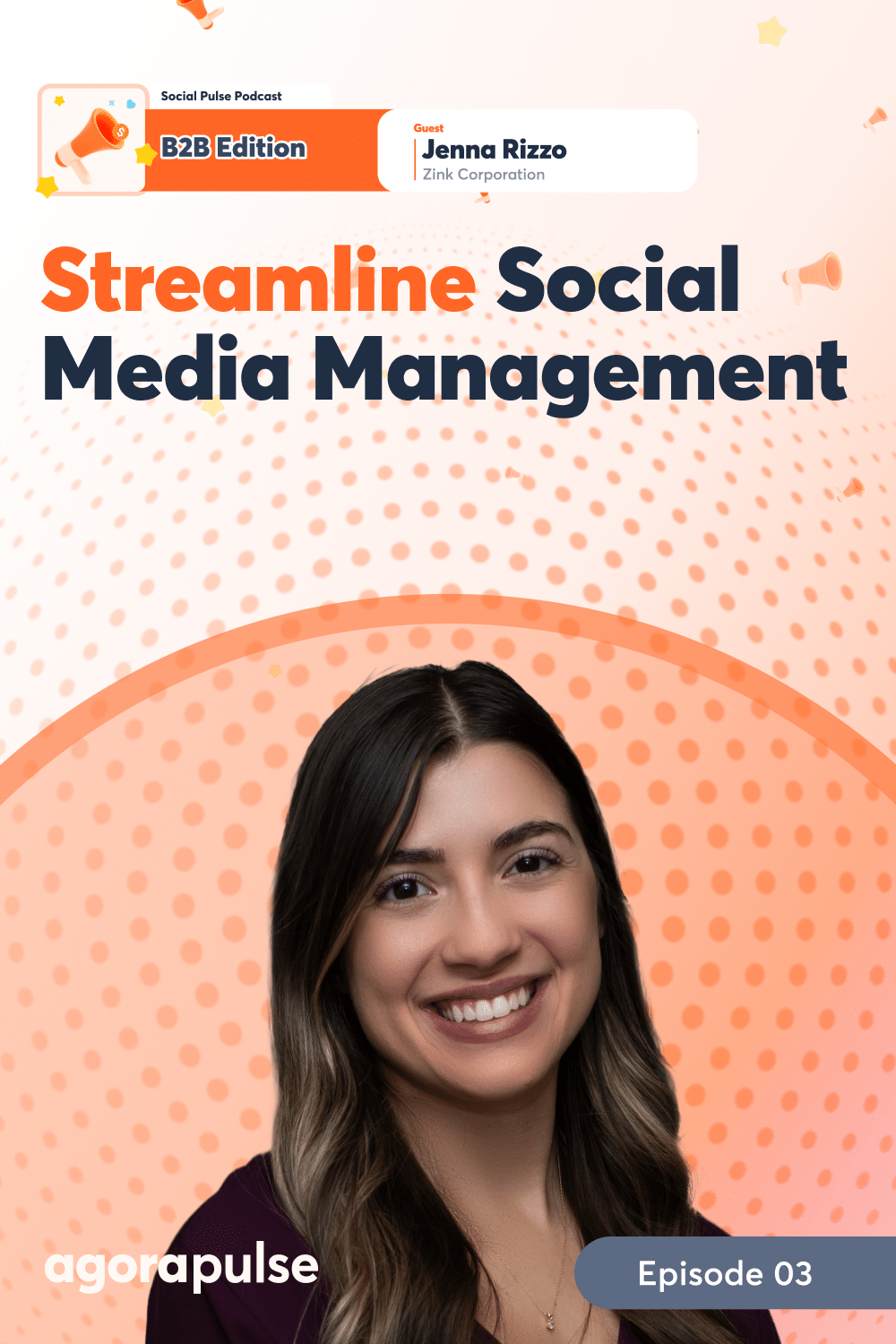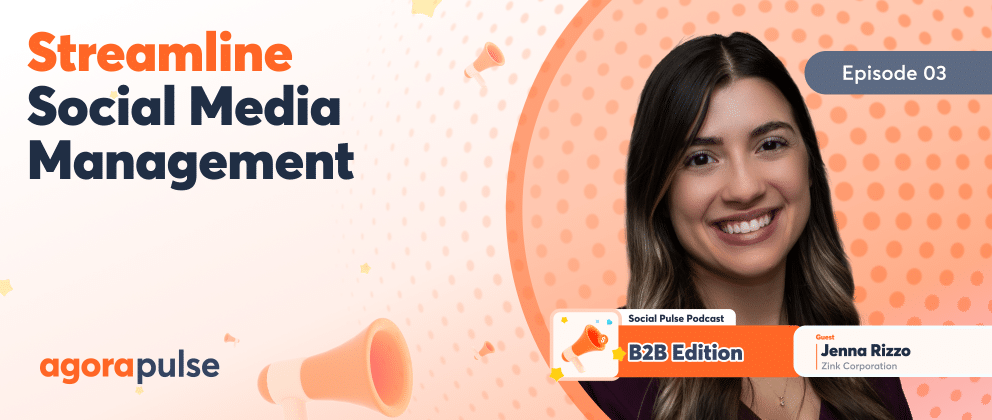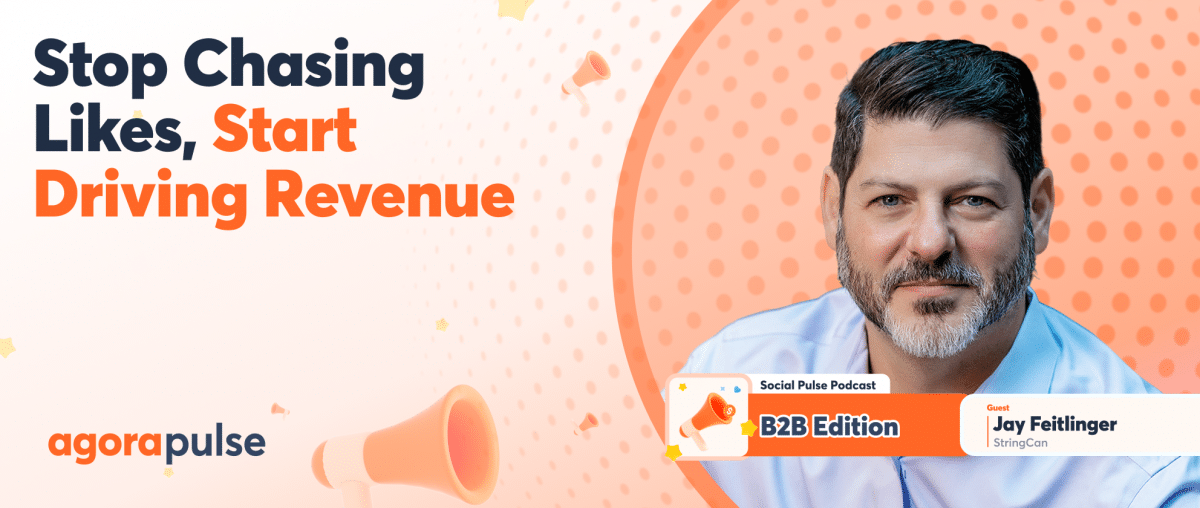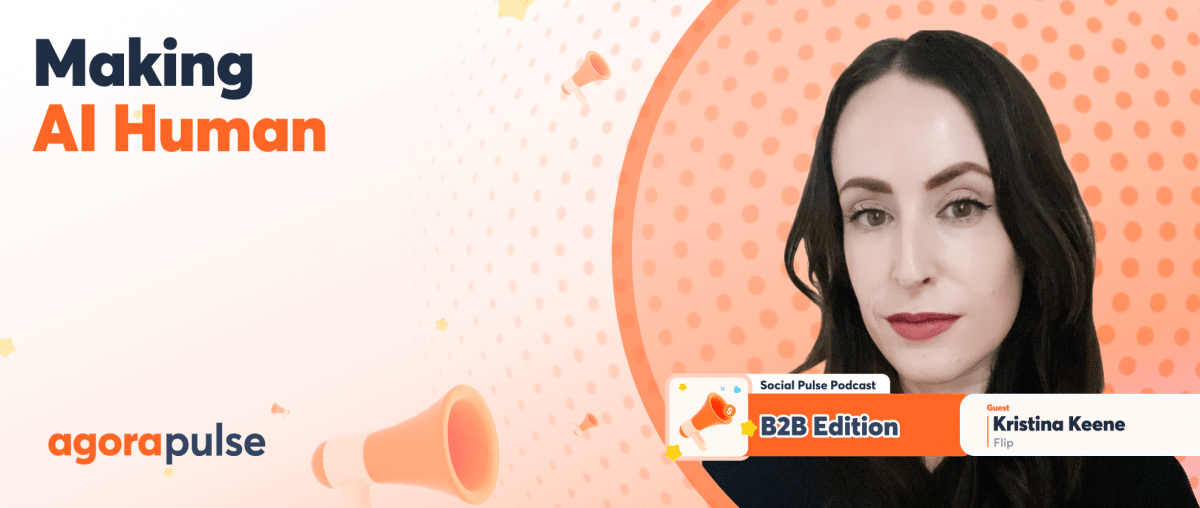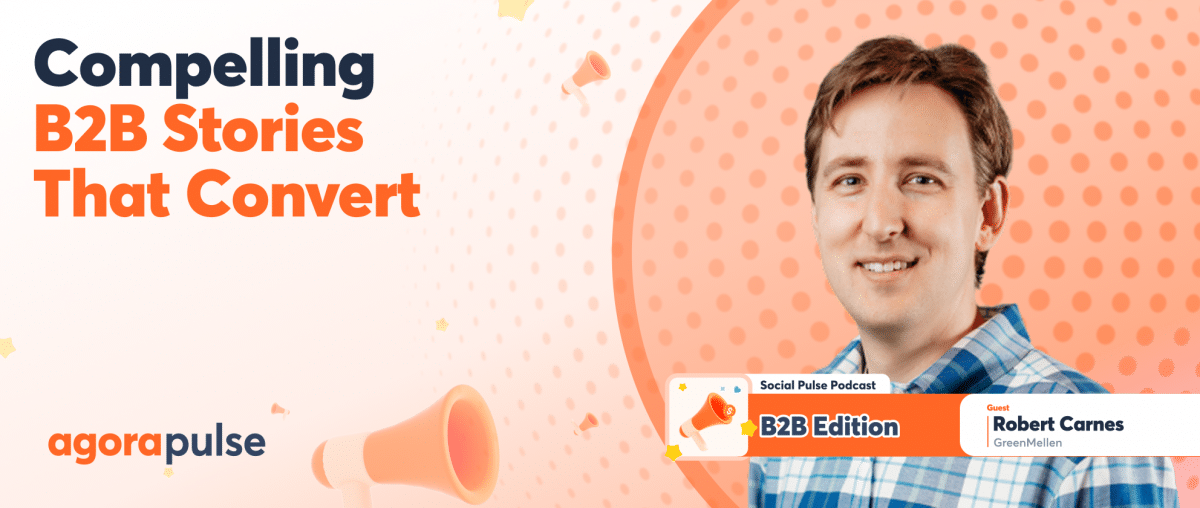Are you tired of juggling multiple social media accounts, drowning in a sea of content approvals, and struggling to maintain consistency across your B2B social media presence?
In today’s fast-paced digital landscape, managing social media for B2B companies, especially in the food service industry, can feel like trying to cook a five-course meal while juggling flaming torches.
But what if there was a way to transform this chaos into a well-oiled machine? What if you could streamline your processes, ensure consistent messaging across all platforms, and save time while improving your social media performance?
Imagine the impact on your brand, your team’s productivity, and ultimately your bottom line. That’s exactly what we’re diving into in this recap of Social Pulse Podcast: B2B Edition, hosted by Agorapulse’s chief storyteller, Mike Allton.
[Listen to the whole episode below or read the recap.]
Mike Allton: Our guest is here to show how her team revolutionized their approach to B2B social media management, turning a cumbersome, time-consuming process into a streamlined, efficient system that set new standards in the food service industry.
Joining us today is Jenna Rizzo, a rising star in digital marketing. Fresh out of Ohio State University with a degree in Communication Technology and specializing in human-computer interaction. Jenna has quickly made her mark as a digital content producer at Zink Corporation. In her role, she has tackled the challenges of social media management, website design, and email marketing head-on, bringing a fresh perspective and innovative solutions to the table. Jenna’s expertise in user experience and design thinking have been instrumental in transforming Zink Corporation’s social media processes—making her the perfect guest to guide us through the revolution of B2B social media management.
Early Challenges in Social Media Management
What did your social media management process look like when you first started at Zinc Corporation?
Jenna Rizzo: Of course. So, it did look like a long and grueling process. I didn’t know much better than what we were doing at first. I was tossed into the process that was previously built, and it looked something like: Let’s form an idea, we’d have great ideas, and then we would create some graphics. I would spearhead that and then figure out exactly how we’re going to caption it.
Then once I would get it approved by my marketing manager. She would compile the graphic and the caption, and try to do about a week’s worth of content all in a Microsoft document.
Then we would send that document to the head of the department that needed to approve the content, and then the content would get built. So then we would take the content. We would put it in our social media marketing platform, so that we can schedule the posts for the week and schedule them out as needed.
But that process was challenging because—with the approvals having to go through just a Microsoft Word document, through an email that just looked like any other email—it got lost in time. It was often that we were faced with the challenge of not hitting the deadlines that we wanted to hit and scheduling the posts when we wanted them to go out based on the content calendar that we had created. So it was grueling, the amount of time that it would take since the department heads wouldn’t even have time to approve all the posts.
Then we had to start ranking the priority of our posts and say, “Does this need to get approved? It’s just a Labor Day post. Let’s just post it. Probably not, but a post about an event that’s important, and we need to drive great engagement and make sure that the information is accurate. We should get that approved, but it’s also on a time constraint. We need to get it out in time to get people to RSVP for the event.”
So it was a difficult process that was just very, very time-constraining.
It was difficult to complete everything that we wanted to complete within the week. We knew that we had so many ideas and so much great content that could go out—but we were just stuck with the approval process [of] “Can you please get back to us on this? We need it,” which I’m sure is a commonality amongst multiple companies, especially in the business-to-business world.
Mike Allton: I know everyone listening—along with myself—we were just cringing while you talked about this process of having to use a document and email it and go back and forth and multiple steps for approval.
I mean, you would never be able to do anything time-sensitive, right? If there was a trend or an event or something that happened outside the business that you want to take advantage of and you knew you only had a short window to do it—forget about it.
What was that turning point that made you realize, “Wow, we need to do something different? We need to change this. We need to completely revolutionize how we’re approaching B2B social media.”
Jenna Rizzo: When I realized how long the process was taking because I wasn’t the one directly getting approvals. However, I would get the cue that “This post is ready. Let’s put it into the social media platform and post it.” Like, okay, great. And then I’d be like, “Wait, I did this two weeks ago. Like, I can’t believe it yet. We’ve got to find a better way to do this. We have so much content on the back burner that it needs to go out.”
We needed to just get it all out there—especially because it’s not just approvals from the department heads. Even word teasing this content to our other partners that we are in business with. They were [asking] “Hey, like, where’s that post that you guys said would get posted two weeks ago?”
So I was like: We have got to find a better solution. There’s got to be something out there.
Especially when I came into working full time, AI had just skyrocketed. I was like, “Look at all the new things that are in front of us to utilize all these new tools that we could use. And there’s no better way for us to get this content and social media posts approved. No way. There’s gotta be something better out there.”
And not to mention, on top of it, we were utilizing Hootsuite. Stuff was failing to publish. We couldn’t export our reports well for any data extraction. There were all those other little things building up, but what mattered most to me was getting content approved promptly, which I knew could not be provided to us at all.
Mike Allton: I’m reminded of a famous scene from the “West Wing,” where Toby and Josh are talking to the ambassador of Indonesia. And they needed a translator. And so they found a guy who speaks Indonesian, but he only speaks Indonesian and Portuguese. So they had to find a different translator who speaks Portuguese and English. And so they’d say hello, and it’d get translated three or four times. And then he’d say hello back, and that was translated through, and it’d just take them forever just to greet each other. And at one point Toby says, “What are we talking about?” He says, “I don’t know. Something we asked him three or four, five minutes ago.” Terrible situation.
Jenna Rizzo: Yes. It resonates with that.
Mike Allton: I feel for you completely, and having used Hootsuite before—yeah, that can be quite the nightmare.
Changes Made to Fix the Chaos
Walk us through the key changes that you implemented to streamline these processes.
What were some of the most impactful adjustments that you guys made?
Jenna Rizzo: We gave it as a quarterly goal to find a new marketing and social media platform. It hit a point where we were paying so much for Hootsuite and not getting what we wanted out of it.
I was like, “There has to be something better, even if it’s just a small little company that’s somewhere way out there.” So we had one of our interns take it upon themselves to just demo anything. We were like, “Set up the meetings. We will come to them. Let us know your findings.”
We got to the end of the quarter. And I think there were three platforms that he ended up presenting to us, and we went through them, and we were comparing and contrasting. He did a great job with graphs of everything that we needed that was most important to us, and there were three things.
The three things were:
- We needed better reporting. We needed to make sure that we could export these reports, and that it was easy to grab the data and use it right away.
- The second thing was that we wanted a way to store our posts and repost them.
- And then, the most important thing to me was a better approval process. We needed to make sure that we could easily get the approval process done promptly.
And so when he was showing us his results, Agorapulse was included in the presentation. I was like, “I don’t even know why you’re comparing all three of them. I think you should just present Agorapulse. It’s clear that every single thing that we need and that we have prioritized Agorapulse is providing and will give us.”
So we set up a meeting immediately after our demo, and we got a walk-through on everything that Agorapulse could provide to us. We were like, “We absolutely have to purchase right now, and we’re implementing it immediately because Hootsuite is giving us none of this.”
“So we were then able to easily complete approvals. We now have custom reports. And we now have a library of all these posts that we can schedule out to be reccurring.
And it has been so impactful in our day to day and saving time and resources.
[Agorapulse] has been absolutely amazing.”
Mike Allton: Love that.
Resistance in Switching to Consistency
So we’ve done some research, and we’re switching to a new tool, which also means changing up some of those processes internally.
Did you have to do anything special to get buy-in, or was pretty much everyone on board from the beginning that you had to change all this?
Was there friction in that old changeover?
Jenna Rizzo: [There’s] an approval in all aspects of marketing if we want to spend over a certain amount of our budget. So we did put together a presentation all together as a team, just to say, “Hey, we’re getting rid of Hootsuite, we’re getting Agorapulse and we can show you why, but trust us. This is going to be good.” And we did a teaser in those custom reports and the approval process and all of that.
But we also did—before we ended up purchasing, which they 100 percent were like, “Yes, approved, go for it”—we did practice the approval process with one of the department heads.
And they were like, “Oh, yeah, that was so easy because we didn’t know what it looked like as an external user.”
So we were like, “We just want to make sure that you enjoy it as well before we completely just spearheaded, get right on it and start building everything in there.”
And he was like, “It’s awesome. It was a click of a button, easy peasy. And it’s approved.”
And I was like, “Wow, that’s awesome to hear.”
Mike Allton: No more Word documents.
Jenna Rizzo: No more Word documents. I barely use Word. I try to use it the least I possibly can in my day to day.
Mike Allton: That’s awesome to hear because I know it’s a struggle for a lot of marketing departments.
It’s not just to Agorapulse. It’s any time we’re trying to buy software that’s just to help us do our job. It’s not directly tied to revenue. It’s not going to manage our ads and drive measurable leads and sales. It’s sometimes a really hard sell. So that’s cool to hear that you got that buy-in.
And I love this idea of bringing in some of the other stakeholders and showing them, “Here’s your role. Here’s in this case, your shared calendar and how that would work and how that would make your life easier and our life easier.” That’s fantastic. I know you manage multiple social media for multiple accounts in the food service industry.
Maintaining Consistency
How are you maintaining consistency across these accounts while you’re still tailoring the content to each brand’s unique voice?
Jenna Rizzo: When I came into my position as a digital content producer, there was only one other person [on] the marketing team.
And I was like, “I need to get to know the brands because we run 10 social media accounts for about seven different companies, and I needed to get to know these companies well.”
I wanted to speak like I was the head of the department at every single one. And then I knew every company’s in and out on social media. And I asked for branding guidelines, and she was like, “We haven’t made those.”
And I was like, “Okay, well, we’re going to start there.”
So the first thing I did when I got to this company was complete branding guidelines, and we’re going to be as uniform as we can on each company’s marketing, social media—especially [since] we need to build out the voice and tone. We need to build out all the colors, everything that is going to be uniform, and keep things looking like they’re all tailored the same way. And we also run on EOS—the Entrepreneurial Operating System. So we already have VTOs built out with everybody’s mission statements, and our core values line up. We are very much a uniform company amongst the 7 different companies of Zink Corporation.
That was an easy way to keep things speaking to the same message in a way.
But I also realized while we were going through different processes, really trying to evaluate our marketing, we found that speaking directly to our target audience—regardless of the company and what impact they had on the food service industry—is helpful because the food service industry has so many different segments and segmented marketing is one of the best ways to market.
You want to speak the right message to the right person at the right time in the right place.
And so we broke it down and tried to tailor the messaging, especially for emails, but also even to social, I mean, looking for groups and different communities within social media to try and tailor our messaging that speaks to the audience that we needed to get to.
And we do that across all of the social media accounts that we have.
Mike Allton: That’s fantastic. I was reminded of an interview I did with the head of social media for MGM, Joseph H. Pomar-Webb. MGM Resorts is a massive collection of hotels and Las Vegas. And when Joseph started, he had to do something very similar. He wanted to know what all the different hotels were like, and he wanted to continue to have that relationship with them, so he was constantly walking through the different properties.
And I love that you guys use EOS. I picked up on that earlier when you talked about how it was one of your big rocks to find. We use EOS here at Agorapulse. I did a whole episode with Matt Heinz on our Social Pulse Podcast: Agency Edition about EOS. So for those who want to know more about EOS, it’s a terrific framework.
I want to go back to that approval process because I was wondering if there’s anything else that you’ve done to help streamline that you’ve got a new tool that’s helping you manage those.
Was there anything else that you’ve done to simplify the content approvals, and how would you characterize the impact that this has had on your efficiency, on the quality of your output, anything along those lines?
Jenna Rizzo: Sure. I mean, the approval process we had was internal and external—of course, the external one was taking much longer because internally we could have marketing meetings and little round tables and say, “Hey, what do you guys think about this post? I want to make it high quality. I want to make sure that it has the correct message to the correct audience.”
So internally we were creating very high-quality posts and getting them approved amongst each other. But when it came to external, you heard about the process before. It wasn’t so easy.
So once we were in Agorapulse, I loved that they even broke it out within Agorapulse that you have internal approvals, and then you have external approvals. And you could have different chat messaging that the external user wouldn’t see. You could just chat internally. So that was a cool feature for us to implement.
And as we added users, now I’m able to approve the content that my content producers create. And then I’m able to send that content to my marketing manager to look over real quick and just make sure that there are no tweaks that need to be made. And then she, with a click of a button, sends it to our external user. They get an email quickly. And then they can just click approve.
They can also see their entire content calendar, which is awesome for the entire month, and further to see all the posts that are going out. It has just been instrumental in our fast pace and the quality of our posts to be able to have all of our conversations, and all the communication in one spot under Agorapulse because then there are no lost messages.
There are no lost notes that might have been on a sticky note or in an email that somebody didn’t see.
Everything is connected to that one piece of content within Agorapulse, making it so much easier to make sure that it is high-quality every time.
Leveraging Automation
Mike Allton: I know you’re using automation with the content approval process, and you touched on a couple of other things before, but I’m wondering:
How else are you leveraging automation when it comes to your social media management, and how has that affected your ability to focus on some of the more strategic and creative aspects of your role?
Jenna Rizzo: Truly, we hit a point where we had a lot of businesses to please by posting about them on social media and highlighting their products and their brand, and it hit a point where we didn’t have the time to create the posts.
There were just way too many.
And then we sat back and we’re like, “We already have great content that we’ve just posted in the past. We just need to save it and reuse it. We’re not going to post it every week, but we should just post every year or semi-annually, whatever we think is best for the content.”
And when we were going through the demo of Agorapulse, we noticed that there was the library tab, and we were like, “Oh, okay. We can put pictures in. Other platforms do that, too. It’s just to save your graphics and your pictures.”
Then it went deeper, and we were like, “Oh, there’s a draft. We can make anything a draft and put it in here and use it whenever we want. This is exactly what we’ve been talking about that we need and that would just make our lives and all of the content that we need to push change for the better.”
And so we started just drafting any post that was a valuable post that was going to get regurgitated and put back out on the platform.
My rock, my 90-day goal this quarter, was to lay out a detailed plan regarding our segments and the best time to reach them and take those Agorapulse posts that are hidden in drafts and take the links and link everything up into one calendar to say, “Hey, we’re going to post this in May during week three,” and just went through all of the posts that we have.
Related post: Unraveling B2B Social Media’s Unique Challenges (And Powerful Solutions)
I combined it with email as well, but it has just been an amazing tool for us to utilize and automate our process for the next fiscal year. We already have part of our calendar done for all of the posts and emails that we need to send out for the year. We’re going to create new content during the year, but this is a great starting point for us to not have to be like, oh no. We need to create content for this brand and for this product, then at least we have things already set and prepared to go out.
Can you share a specific example of a campaign or something where these kinds of improved processes directly benefited that campaign or maybe one of those other businesses that you’re working with?
Jenna Rizzo: Sure. So every quarter we also plan marketing meetings with each brand that we represent. So we represent around 70 plus brands, which is a lot. And then, meanwhile, we’re also marketing for seven different companies. So we need data. We need to show that we are providing value that our content is getting to the right people, at the right time, in the right hands, and that we are tailoring these messages to make sense for their brand. And Hootsuite was not giving us the data that we needed—aggregated data from all of our platforms. We wanted it all in one spot to be able to just send it and put it in a PowerPoint, however, we wanted to do it just easily.
And so when we joined Agorapulse, we were able to customize our reports and utilize them for anything quarterly.
And then we also have weekly statistics that we pull every single week and we can do it with a click of a button. All you do is change the dates and you’re able to pull that data immediately. It’s been amazing. And then on top of it, marketing, it’s always hard to prove your ROI and to show that you are pulling people in the right places and having the feature on Agorapulse to be able to see how many people clicked our unique links and went to our website by connecting Agorapulse with Google Analytics has been awesome for me to see the website analytics and to see who I’m driving to the website. That has been a huge thing that we wanted to get reports on and showcase to our companies. So that has also been an amazing feature that we’ve been using.
Mike Allton: Those are two great examples of features that we’ve developed in the last few years that I just adore being able to create what we call power reports, where you create the report that has the social networks and the data that you want and the frequency at which it’s created and even have it automatically emailed. So to your point, monthly, weekly, quarterly, whatever you need.
And that ROI feature is amazing. And I want you folks to understand that we’re not talking about just creating a single tracking link like you might for a campaign with some UTM parameters. Agorapulse is automatically going to do that, but it’s going to create that unique tracking link for every instance that you’re sharing a post.
So if you’re queuing up a post to go to X and a LinkedIn company page and a Facebook page, it’ll have three different links. If you’re applying to somebody who’s already commented on a post, if you’re applying to a direct message, it’ll have a unique save link, and you can have all kinds of different campaigns.
And then, as long as you integrate with Google Analytics, it’ll bubble up. What happened next? Did that traffic buy something through your site, sign up for a newsletter, or, you know, fill out a contact or a demo request form and that’s worth something to us. So I love the reports that we get for that.
Thank you so much, Jenna, for bringing that up.
What advice would you give to some of us other B2B marketers who may be feeling overwhelmed with some of our current social media processes?
Maybe they haven’t stumbled on Agorapulse like you have. Maybe they don’t have it quite buttoned up like you. What advice would you share?
Jenna Rizzo: Well, I would share that with you should try Agorapulse.
If you have a social media marketing platform that is not going your way, get Agorapulse.
But in different regards to social media, especially, I would say that one of the most important pieces of advice that we have been told is: Absolutely to repurpose your content.
Even you, Mike, were like, “Yes, people do not do this enough.”
That is honestly the best advice that we got. And we only got it last year, and I wish we had gotten it sooner because it is something that everybody should be doing.
You have already created meaningful and purposeful content.
You put it out there for a reason and it drove engagement for a reason.
Reuse it.
Even if you just tweak it a little bit, take out that word that says new or something, or change that date.
You should repurpose it and keep using it.
Looking into the Crystal Ball of Future Developments
Looking ahead, do you see any future developments happening when it comes to trends or technology, particularly in the B2B social media space that you’re seeing coming, whether it’s to your industry or others?
Jenna Rizzo: Sure. I know something that I want to see and that I hope to see is more communities getting built on social media.
The food service industry can get very complex at times where our target audiences stem from restaurants to fast food chains to K-12 food service directors and healthcare operators.
And they’re not all in one place, of course. They like different platforms and they also like to be spoken to differently. And they might need a different way for you to contact them. And so we’ve been trying to do a lot of research on how to get to our target audiences in the best way.
And we’re hoping we found some communities of chefs and K-12 directors, but we’re hoping that these keep getting built out and that we see a trend of new communities that bring together, specific groups that can just [converse] and find the best solutions to their challenges.
I think a corporation is all about finding those solutions and providing you with a comprehensive one that will fix all your problems. So we would like to dive deep into those communities and help them.
Mike Allton: I couldn’t agree more. It’s obvious from the outset of social media that humanity has craved connection with others and has craved having communities where we can join with other people and talk about things that are of interest to us—whether it’s a television show or our professional lives or some other passion project.
And we’ve got one at Agorapulse, the Social Media Pulse Community, that is for social media professionals.
But to your point, it’s not specific to an industry at all. And it’s not talking to specific industries about the things that they’re just dealing with in general. It’s just pure here’s what’s going on with social media.
Our community manager shared today a post about the marketing jobs landscape that a friend of the show, Chris Penn has shared how just there are fewer and fewer marketing jobs available over the past few years, even pre-pandemic. Those are the kinds of things that we talk about in that community.
But you’re right. I think there’s that great need within every industry to have places where we can go to have those kinds of conversations.
Thank you for being an advocate for that. Zink Corporation is fortunate to have you because, Jenna, you’ve been amazing.
Thank you all for listening to [and reading!] this latest episode of the Social Pulse Podcast: B2B edition, where every week we’re talking to marketing professionals like you going through many of the same struggles you’re going through and sharing their stories.
Subscribe to find on each episode, the inspiration, the motivation, and the perspiration that go into growing and scaling organizations like yours. Find us on Apple and leave us a review. We’d love to know what you think! Until next time.
